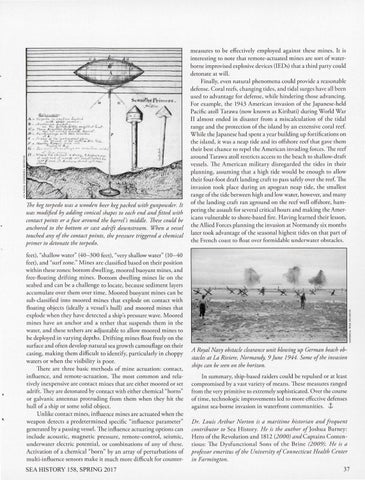~ ctii1itiye J'l'im c rs . fioi(s r.e
/_¡~
The keg torpedo was a wooden beer keg packed with gunpowder. It was modified by adding conical shapes to each end and fitted with contact points or a fuse around the barrel 's middle. These could be anchored to the bottom or cast adrift downstream. When a vessel touched any of the contact points, the p ressure triggered a chemical primer to detonate the torpedo. feet), "shallow water" (40- 300 feet), "very shallow water" (10-40 fee t), and "surf zone." Mines are classified based on their position within these zo nes: bottom dwelling, moored buoyant mines, and free-floating drifting mines. Bottom dwelling mines lie o n the seabed and can be a challenge to locate, because sediment laye rs accumulate over them over time. Moored buoyant mines can be sub-classified into moored mines that explode on contac t with floating objects (ideally a vessel 's hull) and moored mines that explode when t hey have detected a ship's pressure wave. Moo red mines have an anchor and a tether that suspends them in the water, and these tethers are adjustable to allow moored mines to be deployed in varying depths. Drifting mines flo at freely on the surface and often develop natural sea grow th camouflage on their casing, m aking them difficult to identify, particularly in choppy waters or when the visibility is poor. There are th ree basic meth ods of mine actuation: contact, influence, a nd remote-ac tua tion . The m ost common and relatively inexpen sive are contac t mines that are either moored or set ad rift. They are detonated by contact with either chemical "horns" or galvanic a ntennas pro trudin g from them when they hi t the hull of a ship or some solid o bj ect. U nli ke contact mines, influence m ines are ac tuated when the weapon detects a predetermined specific "influence para meter" generated by a passing vessel. The influence ac tu ating options can incl ude aco ustic, m agnetic press ure, rem ote-co ntrol, seismic, underwate r electric potential, o r combinations of any of these. Activation of a chemical "horn" by an array of perturbatio ns of multi-influence sensors m ake it much m ore difficult for counter-
SEA HISTORY 15 8, SPRlNG 201 7
m easures to be effectively employed aga inst these m ines. It is interesting to note that rem ote-actuated m ines are sort of waterborne improvised explosive devices (IEDs) that a thi rd party could detonate at will. Finally, even natural phenomena could provide a reasonable defense. Cora l reefs, changing tides, and tidal surges have all been used to adva ntage fo r defense, while h indering those adva ncing. For example, the 1943 A merican invasion of the Japanese-held Pacific atoll Tarawa (now kn own as Kiribati) during Wo rld W ar II almost ended in di sas ter from a miscalculation of the tidal range and the protection of the island by a n extensive coral reef. While the Japanese had spent a yea r building up fortifications on the isla nd, it was a neap tide and its offshore reef that gave them their bes t chance to re pel the Am erican invading fo rces. The reef around Tarawa atoll restricts access to the beach to shallow-drafr vessels. The A m erican military disrega rded the tides in their planning, ass uming that a high tide wo uld be enough to allow their fo ur-foot draft landing craft to pass safely over the reef. The invasion took place during an apogean neap tide, the sm allest range of the tide between high and low water, however, and m any of the landing craft ra n aground on the reef well offshore, h ampering the assault for several critical hours and making the Americans vulnerable to shore-based fire. H aving learned their lesson, theAllied Forces planning the invasion at N ormandy six months later took adva ntage of the seasonal highest tides on that pa rt of the French coast to float over fo rmidable underwater obstacles.
A Royal Navy obstacle clearance unit blowing up German beach obstacles at La Riviere, No rmandy, 9 June 1944. Some ofthe invasion ships can be seen on the horizon. In summary, ship-based raiders could be repulsed or at least compromised by a vas t va riety of mea ns. 1 h ese measures ra nged from the very primitive to extremely sophisticated. O ver the course of ti me, technologic improvements led to m ore effecti ve defenses against sea-borne invasion in waterfro nt comm u nities. .1
Dr. Louis Arthur N orton is a maritime historian and frequent contributor to Sea Hisrory. H e is the author of Joshua Ba rney: H ero of the Revolution a nd 1812 (2000) and Captains Co ntentio us: The D ysfun ction al Sons of the Brine (2 009). H e is a professor emeritus of the University of Connecticut H ealth Center in Farmington.
37
